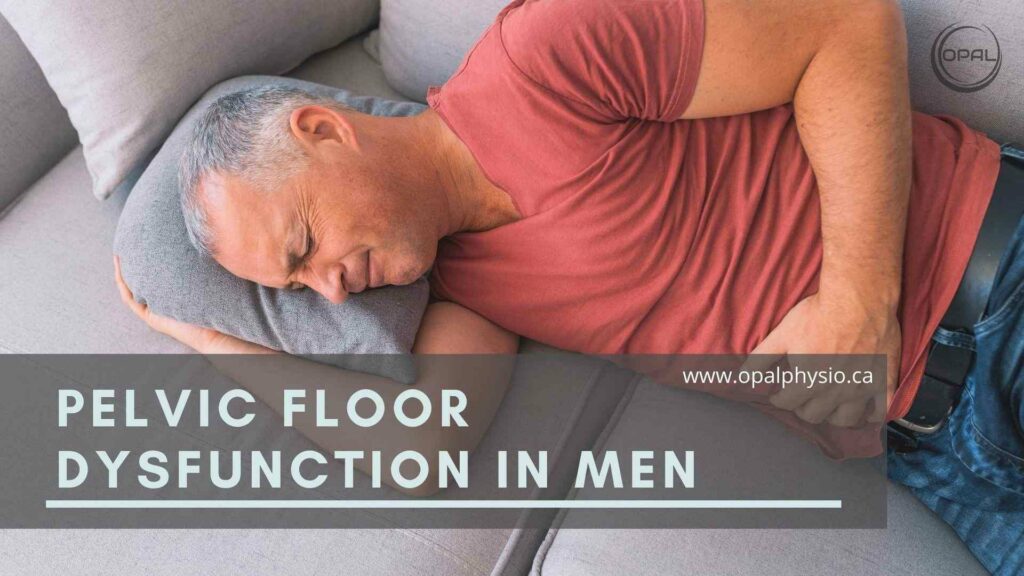Men’s Health Physiotherapy

Men’s Health Physiotherapy:
1 in 9 men are affected by pelvic floor problems/dysfunction. Most men have never heard of pelvic floor physiotherapy, but it is a treatment that can help many different problems associated with pelvic floor muscles. Men can suffer from incontinence and other pelvic floor problems just as women do, and physiotherapy can help treat these issues. Men’s pelvic floor physiotherapy can help to treat or prevent problems with urinary incontinence, sexual dysfunction, and pelvic pain.
Men’s health physiotherapy In Langley
Opal physiotherapy clinic offers Men’s Health Physiotherapy in Langley. Men’s Health Physiotherapy is a specialized area of physiotherapy that focuses on the assessment, treatment, and management of conditions that affect the male pelvic region.
Men’s Health – Male pelvic floor physiotherapy
Men’s health physiotherapy encompasses a wide range of topics including physical, mental and sexual health. One aspect of men’s health that is often overlooked is the importance of maintaining good pelvic floor health.
In recent years, male pelvic floor physiotherapy has gained popularity as a non-invasive and effective way to treat pelvic floor dysfunction in men.
It is important for men to recognize the importance of their pelvic floor health and seek out appropriate treatment when needed.
Male pelvic floor physiotherapy can help address problems such as urinary incontinence, erectile dysfunction, and pelvic pain, which can all have a significant impact on a man’s quality of life. It involves the use of exercises, education, and manual therapy techniques to improve pelvic floor muscle length, strength and coordination. By appropriate muscle training through targeted exercises and education, men can improve their overall pelvic health and prevent or manage these conditions.

Male pelvic floor muscles and men’s health
The male pelvic floor muscles are a group of muscles that support the bladder, rectum, and other pelvic organs in men. They can become weakened, tight, or overactive due to various factors such as aging, injury, prostate surgery, or neurological disorders, leading to symptoms such as pelvic pain, urinary incontinence, bowel issues, and sexual dysfunction.
Strengthening the male pelvic floor muscles through exercises such as Kegels can help to improve muscle tone that supports the pelvic organs, and alleviate symptoms of pelvic floor dysfunction. It’s important to consult with a healthcare provider before starting any pelvic floor exercises to ensure that the kegel exercises are appropriate for your specific condition.
The male pelvic floor muscles provide the following:
- Support to the pelvic organs
- Maintain urinary and fecal continence by controlling the opening and closing of the urethra and anus.
- Increase blood supply by giving erectile tone during sexual intercourse
- Assists in providing stability to lumbopelvic complex and hip joints.
Pelvic Floor Dysfunction in men
When men think of health, they often think of issues related to the prostate and other specific concerns, such as prostate cancer prevention and cardiovascular health. However, problems with the male pelvic floor can also contribute to varying men’s health issues.
It’s not just women who suffer from incontinence and pelvic pain – men can be affected by this condition too and need to be treated just as promptly. Although it’s more commonly spoken about in relation to women, men also suffer from incontinence and pelvic pain and deserve the same level of care and attention.
Male pelvic floor dysfunction may be overlooked or go untreated because most medical practitioners don’t recognize these symptoms can be treated with physiotherapy. At Opal Physiotherapy, our men’s health pelvic floor physiotherapists have experience seeing men with pelvic floor dysfunction and related problem.
What is pelvic floor dysfunction in men?
Pelvic floor dysfunction is a broad term identifying the issues in pelvic floor muscles. It causes impairment in the function of the pelvic floor muscles and organs in the pelvic region, where the pelvic floor muscles can either become too weak or tight or both.
Pelvic floor dysfunction can have a negative impact on the quality of life of men and may require treatment with muscle education or additional treatments such as bladder training and medications.
Symptoms of pelvic floor dysfunction in men
Pelvic floor dysfunction in men can cause several unpleasant symptoms related to urination, ejaculation and erections.
Some of the most common symptoms can include
- Difficulty starting urination or flow of urine
- Urgent urination with possible urge incontinence
- Failing to empty the bladder completely
- Frequency of urine
- Pain while urinating
- Dribble after finishing voiding
- Straining to urinate
- Nocturia (waking up frequently to urinate at night)
- Pain in the pelvic region and abdominal pain
- Difficulty with bowel movements
- Erectile dysfunction
Treatment for pelvic floor dysfunction in men
Physiotherapy is often the first line of treatment for men with pelvic floor dysfunction. We have a range of treatments available to you which include pelvic floor exercises that help to reduce symptoms and improve function. Our physiotherapists are trained in pelvic floor rehabilitation programs which can be tailored for each client. Our physiotherapist will work with you to develop a treatment plan that can include the following:
- Muscle training exercises to strengthen or lengthen the pelvic floor muscles and improve control over them
- Manual therapy techniques to help improve muscle function
- Biofeedback techniques to help you learn how to relax these muscles and use them correctly
- Stimulation devices – such as electrical stimulation over the pelvic floor muscles
- Exercises that target specific areas of the body
- Education
Male Pelvic Floor physiotherapy and muscle training would help restore the normal function of the pelvic floor, bowel, and bladder. Male Pelvic floor muscle training has also been shown to improve urinary continence, post-void dribble and erectile function post-prostate surgery. The goal is to help you regain control over your bladder and bowel function, reduce pain and improve sexual function.
Common conditions related to pelvic floor dysfunction in men
Men’s Bladder and Bowel Conditions
Men’s bladder and bowel conditions refer to a group of disorders that affect the function of the urinary and digestive systems in men. They can have a significant impact on their quality of life, causing discomfort, and embarrassment, and affecting their ability to participate in daily activities.
Bladder and bowel conditions in men can be caused by a variety of factors, including aging, prostate problems, and nerve damage. These conditions can manifest in symptoms such as urinary or fecal incontinence, overactive bladder, and constipation.
It’s important for men to be aware of the symptoms of bladder and bowel conditions and seek advice promptly.
With early diagnosis and treatment, many of these conditions can be effectively managed, improving the overall health of men.
Some common bladder and bowel conditions in men include
Stress Urinary Incontinence
Urinary incontinence is the involuntary leakage of urine. It is a common problem that affects men of all ages and can be caused by a variety of factors, including weak pelvic floor muscles, an overactive bladder, prostate problems, and nerve damage. Stress urinary incontinence is a urinary leakage associated with coughing, sneezing or when being active.
Urinary Retention
Urinary retention is a condition in which a person is unable to empty their bladder. It can be a temporary or chronic condition. In men, it is often caused by an enlarged prostate, blockage of the urinary tract, or nerve problems. In men, one of the most common causes of urinary retention is an issue with the pelvic floor muscles. If these muscles are weak or not functioning properly, they can cause the bladder to leak or not close properly, leading to urinary retention.
Urinary Urgency
Urinary urgency is a condition in which a man experiences a strong, sudden urge to urinate without any loss of urine. This urge may be accompanied by a burning sensation or pain in the bladder or urethra. Urinary urgency is a symptom of several underlying conditions, including UTI, prostatitis, and interstitial cystitis.
Urge Urinary Incontinence
Urge incontinence in men is a condition in which they experience a sudden, strong urge to urinate, followed by an involuntary loss of urine. There are several possible causes of urge incontinence in men, including an overactive bladder, urinary retention, pelvic floor muscle problems, nerve damage, and prostate issues.
Overactive Bladder
Overactive bladder is a common condition in men in which bladder muscles contract too frequently, resulting in urinary urgency, frequency, and leakage. A common cause is an enlarged prostate that can block the urethra and cause urinary frequency and urgency. Other causes include nerve damage, medications, and lifestyle choices.
In men, this can also be caused by pelvic floor muscle dysfunction. When the pelvic floor muscles are not functioning properly, they can put pressure on the bladder and cause it to contract too frequently. This can be a problem for men of any age, but it is more common in older men.
Fecal or Bowel Incontinence
Fecal or bowel incontinence is the inability to control one’s bowel movements and having involuntary leakage of feces or stool. It can be an occasional leakage of the stool to sometimes a loss of full bowel control. There are many possible causes of fecal incontinence in men, including nerve damage, muscle weakness, and, following a rectal surgery causing, sphincter damage.
Constipation
Constipation is a condition in which the stool is hard and difficult to pass. It can be caused by a variety of factors, including pelvic floor muscle dysfunction, diet, medications, and lack of exercise.

Post-Prostate Surgery
Prostate surgery is a common treatment for prostate cancer. However, it can sometimes lead to pelvic floor dysfunction in men. This is a condition where the muscles and tissues in the pelvis area become weak or damaged.
Several things can contribute to post-prostate surgery pelvic floor dysfunction. First, the surgery itself can damage the muscles and tissues in the pelvis. Second, the prostate is located close to the pelvic floor muscles, so removing it can weaken those muscles. Third, some men experience nerve damage during or after surgery. This can lead to pelvic floor muscle weakness.
Some of the problems after prostate surgery include the following:
There are several treatments available for post-prostate surgery. Men’s health Physical therapy is often recommended to help strengthen the muscles in the area to help reduce incontinence and improve muscle function.
Men’s Pelvic Pain Conditions
Men’s pelvic pain conditions are a group of disorders that cause pain and discomfort in the lower abdomen, groin, perineum, and genital area of men. These conditions can range from acute, short-term pain to chronic, long-term pain and may be caused by a variety of factors, such as infections, inflammation, muscle spasms, nerve damage, or structural problems.
These conditions can have a significant impact on a man’s quality of life, causing physical and emotional distress, and often require specialized care and treatment from a healthcare provider that specializes in men’s health physiotherapy.
These pain conditions include
Chronic Pelvic Pain
Chronic pelvic pain in men is a condition in which a man experiences long-term pain in the pelvic area. The pain may be constant or intermittent and can range from mild to severe. The pain is often associated with conditions such as prostatitis, urethritis, or chronic pelvic inflammatory disease.
Pelvic pain can include pain in the penis, testicles, or rectum (without an underlying infection or organic cause). Pain also can be experienced in the lower abdomen or suprapubic area, and pain with voiding, bowel movements, or sex.
Treatment for chronic pelvic pain in men typically involves a combination of pain medications, men’s health physiotherapy, and lifestyle changes. In some cases, surgery may be necessary to relieve the pain.
Bladder Pain Syndrome / Interstitial Cystitis
Interstitial cystitis (IC) is a condition that results in pain and pressure in the bladder and surrounding pelvic area. IC can be a debilitating condition and the IC is often referred to as a “bladder pain syndrome.” The condition is more common in women, but men can also be affected. Interstitial cystitis can be a debilitating condition, causing pain during urination, sexual intercourse, and other activities.
There are a variety of IC symptoms in men, including:
- Pain or pressure in the bladder
- Pain in the pelvic area
- Pain with urination
- Frequent urination
- Urinary urgency
- Inability to urinate
However, these symptoms can be indicative of other conditions that are more common in men, such as chronic prostatitis/chronic pelvic pain syndrome, urinary tract infections or prostate enlargement.
Levator Ani Syndrome
Levator ani syndrome is a condition characterized by pelvic pain and muscle spasm in the levator ani muscles. The levator ani muscles are located in the pelvis and support the pelvic organs. If these muscles become weak or damaged, they can no longer support the pelvic organs properly. This can lead to a variety of symptoms, including pain in the pelvic region, difficulty urinating, and constipation.
Pudendal Neuralgia
Pudendal neuralgia is a condition that can cause pain and tingling or numbness sensation in the area around the penis or testicles. The pain is caused by damage to the pudendal nerve after surgery or from inflammation/infection. The pudendal nerve runs from the base of the spine to the genital area.
Pudendal neuralgia is most often seen in middle-aged or older men, and the condition can be very debilitating. Pudendal neuralgia can also be caused by nerve compression during prolonged cycling and sitting for long periods of time.
Proctalgia Fugax
Proctalgia fugax is a condition that causes anal or rectal pain. The pain is usually sharp and fleeting, and it can happen either with or without a bowel movement. The exact cause of proctalgia fugax is unknown, but it is thought to be related to muscle spasms in the pelvic floor. The condition is more common in men, and it is more likely to occur in people who are under stress or who have a history of anxiety or depression.
Coccydynia
Coccydynia, more commonly known as tailbone pain, can be a real pain in the…tailbone. This condition is usually caused by an injury to the coccyx, which is the bone at the very end of the spine. However, it can also be caused by other things, such as sitting for long periods of time, or even certain types of arthritis.
Symptoms of coccydynia can include a sharp or dull pain in the tailbone area, pain when sitting or standing for long periods of time, pain when moving from a sitting to a standing position, and pain during bowel movements.
Our men’s health pelvic floor physiotherapist will work with you to assess your individual needs and develop a treatment plan that is tailored to you. Treatment may involve exercises to strengthen the pelvic floor muscles, manual therapy techniques, and education on how to manage your condition. Men’s health physiotherapists can help you to improve your quality of life and live an active and fulfilling life.
At our Physiotherapy Langley location, Physiotherapists are trained in Men’s Pelvic Health and male pelvic floor dysfunction and can help you successfully regain control of your health.
Please Contact Us for an initial appointment to assess your condition and provide you with an individualized treatment program.
